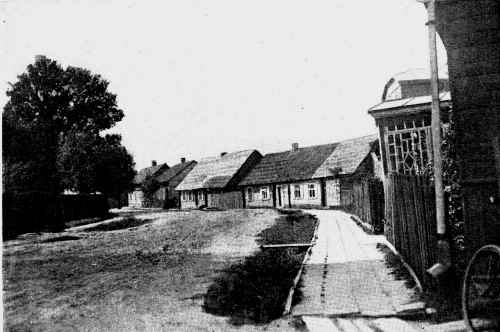 |
|
|
54°51' 23°10'
Griskabudis (Grishkabud in Yiddish) was founded in 1697 in the woods of southwestern Lithuania, 14 km. southeast of the district administrative center Shaki (Sakiai).
Grishkabud was included in the Polish–Lithuanian Kingdom until 1795. According to the third division of Poland in the same year by the three superpowers of those times, Russia, Prussia and Austria, Lithuania was divided between Russia and Prussia. The part of the country to the west of the Nieman (Nemunas) River, including Grishkabud, was handed over to Prussia. During the years from 1795 to 1807 the town was under Prussian rule. In 1797 the population of the town was 582, including just ten Jews.
|
|
| A street in Grishkabud |
During the years from 1807 to 1813 Grishkabud was under the auspices of the Great Dukedom of Warsaw. In 1813, after the defeat of Napoleon, all of Lithuania was annexed to Russia, and Grishkabud was included in the Augustowa Province (Gubernia) and in subsequent years in the Suwalk Gubernia. In the years of Independent Lithuania (1918–1940) Grishkabud was a county administrative center. There was a church that served the many farms of the vicinity. The town held twenty–four market days each year and occasional fairs, which largely provided the livelihood for the Jewish families.
[Page 53]
In 1913, before World War I, about 30 Jewish families lived in Grishkabud. The first census, performed by the new Lithuanian government in 1923, counted 779 residents, including 92 Jews (12%).
According to the government survey of 1931 there were four Jewish–owned shops in town: tools and iron products, textiles, a sewing machine agency and a pub. In 1937 a Jewish butcher and a glazier worked in town. During these years the Jews were forced out of business by Lithuanian competitors, and most of the Jewish businessmen emigrated to America.
In 1936 a fire burned down 22 houses including the Beth Midrash. It was decided to modify the bathhouse that was under construction to include a Beth Midrash. Unfortunately there was not enough money to complete the project and so the community was left without either of them. There was a Heder but in the last years only five boys attended.
|
|
| The market square in Grishkabud |
In 1933 Grishkabud Jews participated in the elections for the eighteenth Zionist Congress. The General Zionist A list received 13 votes, the Labor party received 3 votes and the Mizrahi party received 2 votes.
No Jews were among the eight telephone subscribers in 1939.
In the summer of 1940 Lithuania was annexed to the Soviet Union and became a Soviet Republic. The Lithuanian Soviet regime ended with the invasion of the German army on June 22nd, 1941. On the first day of the war German soldiers entered Grishkabud. There are no details available about the life of the Jews there during Soviet rule and the few months of Nazi rule until September 13th, 1941 (21st of Elul, 5701) when Grishkabud Jews were murdered together with the Jews of Shaki and the surroundings at the Baltiskiai Forest, 1.5 km north of Shaki.
[Page 54]
|
|
| The mass graves with the monument at Baltiskiai forest. The Yiddish inscription on the plaque reads: “In this mass grave lie four thousand innocent residents of Shaki and the surrounding district, who were murdered in the years 1941–1944 by the German Fascists and the Lithuanian Bourgeoisie nationalists. Their bright memory will be kept forever in the hearts of the patriots of our homeland.” Because this tablet was erected during Lithuanian Soviet rule, it does not specify that Jews were among the murdered. |
|
|
| Entrance gate to the site of the mass graves. The inscription in Yiddish, Lithuanian and Russian reads: “At this place in 1941–1944 the Hitler murderers and their local helpers murdered about 4000 Jews, men, women, children.” |
Sources:
Folksblat, Kovno, 6.8.1936
|
|
JewishGen, Inc. makes no representations regarding the accuracy of the translation.The reader may wish to refer to the original material for verification.
JewishGen is not responsible for inaccuracies or omissions in the original work and cannot rewrite or edit the text to correct inaccuracies and/or omissions.
Our mission is to produce a translation of the original work and we cannot verify the accuracy of statements or alter facts cited.
 Protecting Our Litvak Heritage
Protecting Our Litvak Heritage
 Yizkor Book Project
Yizkor Book Project
 JewishGen Home Page
JewishGen Home Page
Copyright © 1999-2026 by JewishGen, Inc.
Updated 06 Mar 2019 by JH